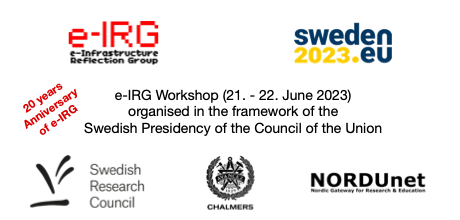-
20 years of e-IRG Anniversary event
e-IRG will celebrate its 20 years anniversary since the first e-IRG workshop in June 2003 in Athens with a dedicated session. The session will have a short overview on the historical evolution of e-IRG, its contribution and impact to the current e-infrastructure landscape in Europe and beyond, and then focus on the key issues that need to be dealt with in the years ahead. This will include all e-Infrastructure areas and their tight cooperation for the benefit of the end users, such as leading-edge hyperconnectivity via GEANT and the NRENs, EOSC with its underlying federated European and national e-Infrastructures including NGIs, and the needed steps for EOSC to become an indispensable tool for both the end users and providers, the cutting-edge EuroHPC supercomputing and quantum communications/computing infrastructure and services ecosystem, and finally the Common European Data Spaces and their federation via the SIMPL middleware. The vision of e-IRG on "facilitating integration in the area of European e-Infrastructures and connected services, within and between member states, at the European level and globally", not only continues to apply, but in fact is timelier than ever, requiring strong interplay among all e-Infrastructures stakeholders.
-
1 - Authentication and Authorisation Infrastructures coordination in the ERA and beyond
Authentication and Authorisation Infrastructures (AAI) is major area requiring a common global ecosystem for identity and access control across all relevant e-Infrastructures, spanning from EOSC and EuroHPC, but possibly expanding to new areas such as the European Data Spaces and the SIMPL framework. Significant effort has been devoted in this area, starting with blueprint architectures followed up by concrete implementations and adaptors that have been developed. As highlighted in the e-IRG White Paper 2022 following a questionnaire to all major e-Infrastructure-related initiatives, there are multiple providers and more effort is needed to make AAI more user friendly and transparent, especially when using services across all these different service providers. The session will discuss the current developments in AAI and the need for coordination and interoperability across all the different service providers, including EOSC, EuroHPC and EU Data Spaces.
-
2 - Cybersecurity and critical infrastructures
The NIS-2 Directive pertains to safeguarding the security of Vital Digital Infrastructures, which are crucial for sustaining society. These infrastructures encompass various industries such as healthcare, power generation and transmission, and with importance to e-IRG research and education. Specifically for research e-Infrastructures and in particular NRENs, the NIS-2 Directive mandates that government agencies in the domain of Digital Infrastructures (e.g. those providing TLD management, DNS and Cloud computing service and Data centre services, and Trust services) should adhere to its requirements, meaning that most e-Infrastructures in the research domain fall under its purview.
The obligations set forth by the NIS-2 Directive are generally reasonable and expected as part of regular work, but it is crucial to document and demonstrate compliance. The NIS-2 Directive also requires regular audits of compliance, making it imperative for e-Infrastructures to be well-prepared. To this end, some essential steps e-Infrastructures can take include establishing contacts with their national government, appointing a coordinator for compliance and reporting, evaluating their current security baseline status, identifying their obligations under the NIS-2 Directive, and comprehending the necessary measures to bring their organization up to the required level. -
3 - Coordination among generic and thematic infrastructures in the new ERA
e-IRG has been working on the topic of coordination between thematic and generic infrastructures at institutional, national, regional and EU levels, as well as among the generic infrastructures themselves for quite some time now, with the e-IRG National Nodes document in 2019 and the e-IRG White Papers 2021 and 2022.
21–22 Jun 2023
Malmö, Hotel Clarion
Europe/Copenhagen timezone

